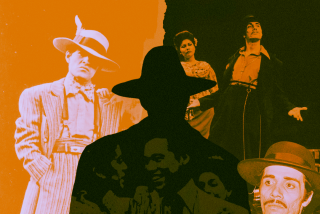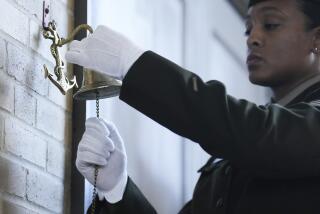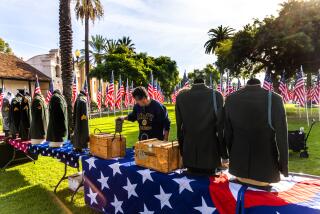The ‘Soul’ of Black Military History : Museum at Arizona’s Fort Huachuca Devoted to Exploits
- Share via
FORT HUACHUCA, Ariz. — For 60 years, from 1892 until 1951, this old Army post 15 miles north of the Mexican border in Cochise County was the largest military base for black soldiers in America.
The black soldier is featured at the fort’s museum, one of 70 Army museums in the country, making February--Black History Month--the busiest time of the year, said Jim Finley, museum director.
“We get requests from U.S. military bases around the world during Black History Month for information on the history of the black soldier,” said Finley, 45. “Fort Huachuca is the heart and soul of black military history.”
It wasn’t until 1951 that the last of the racially segregated Army units were disbanded. Before the Korean War, Fort Huachuca was an all-black Army base except for a small nucleus of white officers.
World War II Role
During World War II, the all-black 92nd and 93rd divisions trained here before going overseas to fight in Italy and the Pacific islands. It was also a major center for black WACs (Women’s Army Corps) during World War II.
From 1931 to 1942, Fort Huachuca was headquarters for the all-black 25th Infantry Division. From 1913 to 1931, the black horsemen of the 10th (Buffalo Soldier) Cavalry called this 73,000-acre military post at the foot of Thunder Mountains home.
And, from 1892 to 1913, each of the nation’s four black regiments, the 9th and 10th Cavalry and the 24th and 25th Infantry, were stationed here at various times.
Huachuca is Sobaipuri Indian, meaning place of thunder. The fort lies at the foot of Thunder Mountains in southern Arizona. Carter Drive is a main thoroughfare at the base, named after Col. Louis A. Carter, black chaplain here from 1913-15 and 1935-40.
Lt. Gen. Emmett Paige Jr. is commander of this post and also commanding general of the worldwide U.S. Army Information Systems Command, with 37,000 military and civilian employees serving in a dozen countries.
The command is responsible for air traffic control systems, the Army’s telephone and communication networks, automation systems and data processing.
Paige, 55, a native of Florida, is a high school dropout who joined the Army 38 years ago. While in the Army he earned a bachelor’s degree from the University of Maryland and a master’s degree from Pennsylvania State University. He was the first black general in the history of the Army Signal Corps.
Today, Fort Huachuca is the only Army base in Arizona. With 12,000 military and civilian personnel, it is the largest employer in southern Arizona.
“I get an awesome feeling every time I walk around the old part of Fort Huachuca. I think back to what things must have been like in this wilderness when the Buffalo Soldiers were here,” mused Command Sgt. Maj. Raymond R. Polk Sr.
Polk, 50, was standing in the shadow of the 9-foot bronze statue of a Buffalo Soldier at the main gate of the Army base. The statue depicts a soldier in the cavalry uniform of the late 1800s, grasping his gun in one hand and a saddle in the other.
The statue was erected in 1977 on the 100th anniversary of the establishment of Fort Huachuca. An inscription at its base reads: “The Buffalo Soldier, symbol of the proud heritage of the black fighting man. . . . “
Strictly speaking, the name Buffalo Soldier belongs to those black cavalrymen who fought in the Indian wars of the 1870s and 1880s, since it was the Indians who came up with the nickname.
“It was the plains Indians who gave the black cavalrymen that name,” writes Cornelius C. Smith Jr. in “Fort Huachuca: The Story of a Frontier Post.”
“Some say the Indians likened the short curly hair of the black soldiers to buffalo hide,” Smith noted. “Others say when the American bison was wounded or cornered, it fought furiously, displaying uncommon stamina and courage, characteristic of the black trooper in battle.”
‘Home of Buffalo Soldier’
Museum director Finley said, “If the sobriquet Buffalo Soldier has come to stand collectively for the black men who served in four regular Army regiments from 1866 to World War II, then Fort Huachuca has earned the distinction of being home of the Buffalo Soldier.”
Exhibits in the museum depict, for example:
--The part played by the Buffalo Soldier in skirmishes with the Comanche, Kiowa, Apache and Sioux.
--Black soldiers punching a hole through Spanish lines on a Cuban hilltop so Teddy Roosevelt and his Rough Riders could dash through it.
--Buffalo Soldiers following the trail of Pancho Villa through Mexico in 1916 with Gen. John J. (Black Jack) Pershing.
--Black soldiers training at Fort Huachuca and overseas in World War I and World War II.
--Photos of Lena Horne, Pearl Bailey, Hattie McDaniel, Joe Louis, Louis (Satchmo) Armstrong and other black entertainers visiting the base in World War II.
There are scrapbooks filled with memorabilia of troops stationed at the Army post. A quote from Lt. Wade McCree Jr. of the 365th Infantry, now a professor of jurisprudence at the University of Michigan, appears in a display: “Many did not like Fort Huachuca. I did. I liked the desert and the surrounding mountains. I was undoubtedly the exception rather than rule in enjoying the physical isolation of the Fort. . . . “
“I have been stationed at Fort Huachuca a year and three months and never knew this was here,” said Pfc. Wallace Casey, 23, of Baltimore as he viewed the displays in the fort’s museum.
Casey was at the museum because of his friend, Sgt. Johnny Richardson, 24, of Greenville, S.C. Richardson, who has been at Fort Huachuca two years, had gone to the museum to get information for a visiting dignitary when he noticed the exhibits about black soldiers.
He said he immediately found his two buddies, Casey and Pvt. Tommie Ingram III, 20, and brought them back to see his discovery.
During his year at the fort, Ingram, of Pompano Beach, Fla., had passed by the museum several times but didn’t know what was inside. He, too, knew nothing about the Buffalo Soldier.
“This makes me feel like we’re worth something,” Ingram said. “You never hear any mention about blacks playing an important part in the Army years ago. I’m awfully proud of this. It really makes me feel good.”
More to Read
Sign up for Essential California
The most important California stories and recommendations in your inbox every morning.
You may occasionally receive promotional content from the Los Angeles Times.










